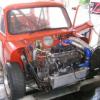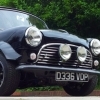Racer 'unstable' Under Hard Braking !
#16

Posted 06 May 2012 - 05:21 PM
to be honest it sounds like to much rear braking...
#17

Posted 06 May 2012 - 06:43 PM
I'd fit some better tie rods anyway, regardless of any problems your having. Standard tie rods are pretty flimsy and flex a lot under heavy braking. For a racer i'd fit some big heavy duty rose jointed versions and reinforce the mounting tabs for them too.
As said, nothing really wrong with standard stuff. and it may be a requirement that it is all standard, lots of mini race regs stop you using spherical joints.
#18

Posted 06 May 2012 - 06:55 PM
Didn't really think about the reg's though...
Edited by mike., 06 May 2012 - 06:58 PM.
#19

Posted 06 May 2012 - 07:15 PM
pressure regulator on the back subframe.
As Icklemini says, which one? That jumped out at me right away when you described it, given that the problem seems to depend on the level of deceleration. Is it the pressure based one or the innertia one?
#20

Posted 06 May 2012 - 07:53 PM
#21

Posted 06 May 2012 - 08:00 PM
The rear brakes must do their share of braking - I tried in the past reducing the rear bias to the point where the rear brakes were doing virtually nothing (no heat in the drums) - and the car was VERY unstable when braking hard. I then slowly increased the rear bias until the rear wheels were 'not quite' locking on a dry road with no weight in the back of the car , and that was very much better.
well you will be surprised at how many racing cars out there have very little rear braking... from rallycross to miglias....
MSA regs say that the rear brakes must 'work' but not state how efficient.
Results may vary...
#22

Posted 06 May 2012 - 08:12 PM
#23

Posted 06 May 2012 - 10:01 PM
#24

Posted 06 May 2012 - 10:32 PM
No matter what, the mini, by design, will have a shifty rear end under heavy braking.
Now, some things that may be contributing to more of a shimmy than what is to be expected, that really throw me off are the following:
Worn cones: I bet this is the main issue; uneven ride height between wheels, and the dampers working harder then they have to to compensate for the worn cones.
Custom Tie Rods: If there is any play in these, or they are not adjusted evenly, the odd pulling at the rear could be possible.
Brake Balance: Yes, if the rears lock up on a mini, bad things may happen. but I still am going to disagree with how you're adjusting the brake bias. All that needs to happen is that the fronts need to lock up BEFORE the rear, always. once you have fulfilled that, the rears should still be able to lock. rears locking first is bad, but the rears locking soon after the fronts is not bad at all. if the front locks, simply let off the brake pressure until they regain traction. if the rears aren't being fed any pressure, the momentum of the rear wheels will still be trying to push the car forwards, while the front wheels will be resisting that force. this makes the rear end squirly. anyone who has raced a motorcycle knows that the fastest way to stop is to have just slight rear brake pressure to keep the rear wheel slowing down, but not skidding.
also, if you're racing, you should have the car corner weighted. a lot of the problem you are mentioning can be fixed with a corner weight job.
and come on, doing any amount of speed, let alone racing competitively, on worn components is a horrible idea. if you're not going to spend the money to do it safely, do not do it at all. this is not a nag; I can understand not having the money to buy new parts, but never put your fun too far ahead of your safety.
#25

Posted 06 May 2012 - 10:37 PM
If anything, this is expected behavior; if you are braking INTO the turn, the car should be oversteering more than usual because of the design of the mini; think of it as trailing throttle oversteer, but the effect magnified by the weight balance to the front of the car and the front end being able to receive far more traction than the rear. To compensate for this slightly, you may want to alter tire pressure to make sure the rears are getting as much heat into them as they can, to aid in traction at the rear.
#26

Posted 07 May 2012 - 02:45 PM
The brake pressure problem is complex, because a pressure limiter valve is not a proportioning valve, and if it is set to prevent rear wheel locking on a dry surface, they will lock in the wet, because its action is based on pressure. A deceleration controlled valve is no better. In a road car either type would need to be set to prevent locking in the wet, which would deprive you of maximum braking in the dry,
A true proportioning valve, which shifts the pressure ratio proportionally at the rear with respect to the front, is not feasible. The Willwood valves, which are rather good at what they do, and not all that expensive, are basically dual slope, where up to the set point the rear pressure follows the front, above that a ratio is introduced so it follows at a slower rate. They are, and can't be, truly proportional over the full range, so they are a bit of a compromise, the best that can be obtained with simple hydraulics.
True proportional valves are only possible in pump-driven systems like some Citroens, as they require return of fluid back to the reservoir to make them work. But such a valve does allow correct front/rear proportioning in all conditions, or even better, proportioning according to load on the wheel, so all will lock together. But you will not be fitting a system like that to a Mini, for various reasons.
A much simpler way of achieving the same objective of true front to rear proportioning is a simple twin master cylinder and balance bar setup. It can be set up to that the rear wheels will lock just after the front, in both dry and wet conditions. Bujt I don't know if the regulations allow it. They are dubious on road cars too, unless the balance bar has been set and permanently locked. You never use a pressere limiter valve of any type with a balance bar setup, as it destroys what you have achieved, true proportioning.
But I am suspecting that it is not a brake problem, but toe change during braking. Possible causes are worn radius arm bearings or insufficiently rigid subframe. (Some of the poorly designed alloy crossbeams which are used, in conjunction with coilovers, to replace the subframe in a misguided attempt to reduce weight are prime suspects, so are normal subframes which are not in perfect condition.) The design of the rear will result in any flexing due to heavy braking causing a shift towards toe out, and the handling deteriorates very rapidly if the wheels deflect beyond the parallel position. I don't know if lightweight radius arms are available, but if so, they would also tend to give rise to the same problem, as they would be less stiff than the originals.
A steel subframe might be stiffened slightly, in the direction which matters, by seam welding the edges of its front box section, and seam welding the side members, especially their joint to the front crossmember, would add a little bit more stiffness. Just wondering what subframe is being used, as there have been numerous tales of inadequate number of spot welds in non-genuine replacements. As well as being dangerous due to the possibility of sudden failure, that would likely allow too much flexing.
#27

Posted 26 May 2012 - 03:27 PM
Firstly I need to thank each and everyone for all the feedback. I had a blast researching and searching for answers. I have fitted the minispares upgraded tie rods, redone the suspension setup, but have not yet been back on the track. We have a practise session this saterday.
Although, after working on my car today, and it's left at the track in a garage, I decided to take a drive around the outside of the track. Some parts are tar and other gravel ...... What a hard and bad experience. After the second bump in the road it sounded like the suspension is going to pop through the front fire wall. Back at the pits, peeping under the front, I,ve noticed that on the right hand side the bum stop is about 3mm from the top arm whereas the left side is about 10mm.
I am sure that is contributed to the unstableness under braking ?
What should the gap between the standard bum stop and the upper arm be ? I have read that some chaps cut the original bump stops to get the required gap, so with lowering my car and suspension setup, I will need to "modify" the one bump stop for sure.
#28

Posted 26 May 2012 - 03:31 PM
I do not have a rear anti roll bar, but have read that bump stops can be installed on the rear radius arms, and as per mini mania, it is suggested for competition cars. What is your taking on it ?
Is it worth it ?
1 user(s) are reading this topic
0 members, 1 guests, 0 anonymous users




















